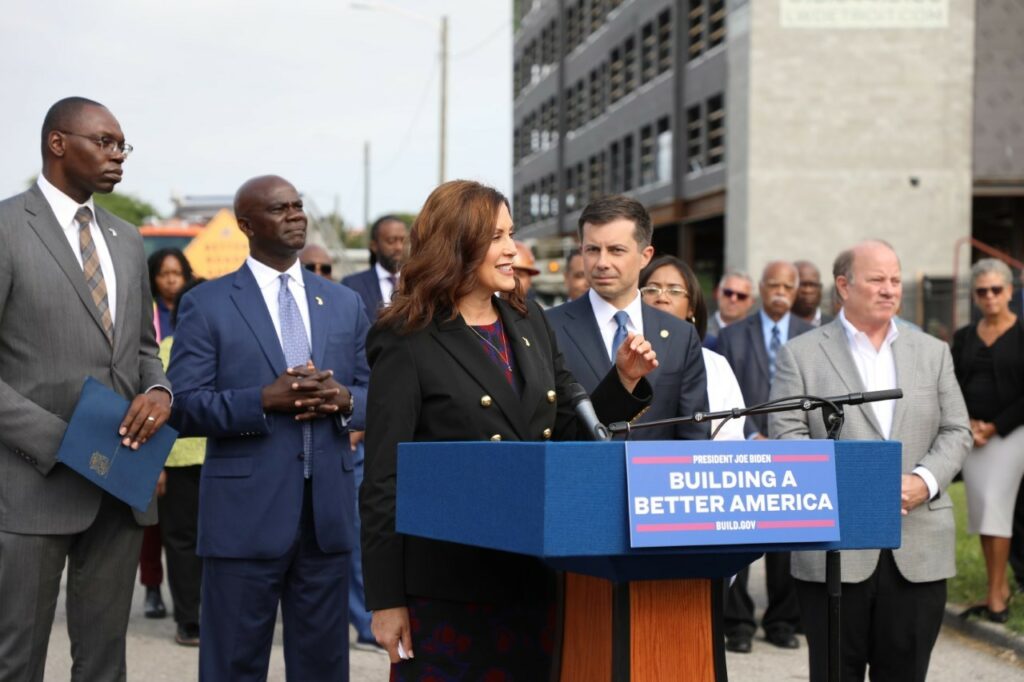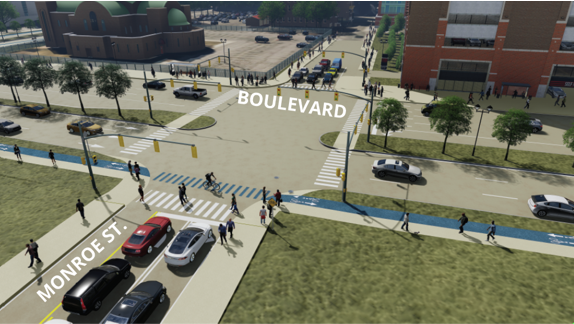Reconnecting Communities and Bringing Sustainable Infrastructure Opportunities to the Future

The conversion of I-375 into an urban boulevard is a profoundly meaningful project that will replace the divide that leveled the Black Bottom neighborhood and Paradise Valley entertainment district more than 60 years ago. Now, the Michigan Department of Transportation (MDOT) is funneling $104,657,051 from the President’s Bipartisan Infrastructure Law that passed last year to replace the one-mile-long freeway and develop a lower-speed urban boulevard with the impetus to recognize the wrongdoing of the past and get it right for the future. In this – the second of our two-part series, Jonathan Loree, MDOT senior project manager, talks about the importance of the project in terms of social and environmental justice, as well as development and infrastructure. Loree has worked for MDOT for 18 years and has been involved in the design, construction, and planning of major projects, including work as MDOT’s lead on the M-1 Rail streetcar on Woodward Avenue. He has been project manager for the I-375 Improvement Project since 2017. Q: From your perspective, what will this new boulevard bring to the area? A: I think it’s about connection. Reconnecting communities and creating new opportunities for those communities. I- 375 was built during the freeway boom and in the name of ‘urban renewal,’ and it’s just not the right infrastructure for the last mile into downtown, so it was time to look at how we can make this area more efficient and move toward a more sustainable and connected future. This is the heart of the city, and the boulevard will serve pedestrians and cyclists well, and move people around better – in ways that the freeway clearly cannot accomplish. The way downtown connects to neighborhoods – both east and west, as well as north and south – will be drastically improved, and some elements of the former street grid will be redesigned back into the road network, where possible. Ultimately it will be a much more useful corridor in terms of moving people around, offering walkable options, and opening real estate for potential development. This will also eliminate some of the vehicle usage in that area and effectively replace a large concrete infrastructure with a more environmentally and community-friendly passageway. Q: What about the sustainability aspects? A: This project gives us roughly 31 acres of property beyond the roadway since we will be reducing the pavement footprint. Developing this land toward furthering the community, the economy, and social equity is absolutely the goal. And to achieve this, stakeholders, the city, and the residents are working together. There will be pockets of spaces and medians, etc., that will give us opportunities to improve the aesthetics and environment – whether that be plants and vegetation and grass or artwork or items that commemorate the past. And from a sustainability standpoint, we’ll be eliminating the bridges and reducing the amount of pavement and replacing that with a boulevard that better serves the area now and into the future. We also are implementing a new stormwater management system. Q: How will the new system help ameliorate stormwater issues? A: Clearly the recessed freeways and current stormwater systems are not built to handle the multiple 100-year storms that we are seeing. There is just no place for that much water to go within the current system. This project gives us the chance to build new infrastructure to handle it much better for the area in the future. We’ll be constructing gravity-fed pipes that will allow us to treat and release the water directly to the Detroit River. This will take the load off of the current system, which consists of two aging pump stations and outlets into the Detroit Water and Sewerage Department system. Less flow in the combined sewer system will help mitigate the overflow and flooding on the freeway and in nearby homes. Q: What are the economic factors? A: This is a very valuable piece of property close to downtown, and it’s a high-traffic area with a lot of potential for development and new businesses. We’ll also be putting people to work and looking for minority contractors to work on the project. The connectivity between neighborhoods means more people on foot and on bicycles to walk into stores and restaurants and bars and improve business in those areas. Q: Speaking of putting people to work, this project will involve workforce development, correct? A: Yes. We want this property to provide long-term benefits and we are looking at leveraging the project and the outcomes toward that. This includes workforce development, providing more opportunities to disadvantaged businesses, entrepreneurs and small business enterprises and more. Construction begins in 2025 and we are currently looking at how best to engage and get people involved in trades and training people to participate. Q: Is this a unique project for MDOT? A: Absolutely. We are embarking on a design and construction project to acknowledge mistakes made in the past and create better infrastructure for the future. Not only for the corridor but for the city and state and for the people. Honoring the past and building an environment that facilitates live, work, and play for now and into the future is important and necessary. Q: What about planning for future connectivity and technology? A: There is a lot of talk about autonomous vehicles and interest in how transit will play into this and what that looks like for the future. We will develop this infrastructure to support and facilitate flexibility for the future to the best of our ability and knowledge now. Be sure to subscribe to our newsletter for regular updates on sustainable business practices in and around Detroit.
A New Boulevard for Social Justice, Connectivity, and Economic Impact

The development of I-375, the extension of I-75 that runs into downtown Detroit, leveled the Black Bottom residential neighborhood and the Paradise Valley entertainment district when it was constructed in the late 1950s and early 1960s with economic impact displacing 130,000 people, hundreds of small businesses, churches, and more. The city has been divided by the highway for over 70 years. Now, the Michigan Department of Transportation (MDOT) is funneling $104,657,051 from the President’s Bipartisan Infrastructure Law that passed last year to replace the one-mile-long freeway and develop a lower-speed urban boulevard with the impetus to recognize the wrongdoing of the past and get it right for the future. The project proposes three elements of study, design, and research. The first is understanding the urban design profile … how this area is developed to reconnect Downtown Detroit and the riverfront to the surrounding neighborhoods. Second is the final boulevard design, which is intended to enhance the urban experience based on City of Detroit design standards and offer new economic opportunities via business development. Finally, the framework will determine how diversity, equity, and inclusion can be used to create opportunities for Detroiters, taking the history of the land into consideration. This is the first of a two-part article that will cover the project’s social justice, connectivity, and economic impacts. In this article, MDOT Director Paul C. Ajegba talked to SBN Detroit about this ‘very unique and challenging project.’ With more than 31 years of experience at MDOT, Ajegba established the position of chief culture, equity, and inclusion officer at the deputy director level within his leadership team. This followed his work to establish MDOT’s Historically Black Colleges and Universities (HBCU) Transportation Diversity Recruitment Program (TDRP). The program is a partnership between MDOT, the Federal Highway Administration (FHWA), the American Council of Engineering Companies of Michigan (ACEC), and Michigan colleges and universities, offering on-the-job training to minority undergraduate students pursuing degrees in engineering. Ajegba is a member of the Conference of Minority Transportation Officials (COMTO) and serves on the following boards: the American Association of State Highway and Transportation Officials (AASHTO) (vice president), chair of the AASHTO Council on Public Transportation, ITS America, Mcity, the University of Michigan Civil and Environmental Engineering Friends Association (board president), the Engineering Society of Detroit, and the . Q: What is the impetus behind the I-375 project? A: It is a way for us to recognize that things were not done right in the past, and it is our opportunity to get them right. In the early ‘50s, Black Bottom was a large community with many thriving African American residents and businesses. In those days we did not have the community engagement that we do now. City planners decided that the best use of the area was to build a freeway and they did it, causing the displacement of thousands of residents and many successful businesses. So, the impetus behind this project is to take a step back and rethink the way we plan and design, build our infrastructure and then build it with the users, stakeholders, businesses, and residents in mind. It is the opportunity to conduct a 360-degree review of all areas of impact and make decisions that are right for everyone. The equity and inclusion piece of this is huge. We are being meticulous and methodical in how we plan to make sure the community is engaged every step of the way. Q: What is the narrative around the topic of equity? A: We need to bring equity into our transportation infrastructure. We cannot erase the mistakes of the past, but what we can do is make sure we look through and operate through a lens of equity going forward. Several different uses of this area have been on the table. We engaged with the community and together decided that creating a boulevard that will attract new development and connect neighborhoods is the best use of the corridor. Q: How will this project honor the history of Black Bottom and Paradise Valley? A: We are currently in the design process and considering all different ways to do this and we are hiring a historian to help with this aspect. Recognizing and honoring what took place here will be built into the aesthetics of the whole corridor. You will see this reflected in the project overall. Q: Is this project part of a larger shift toward building state infrastructure with equity in mind? A: I think there is a big shift taking place not only in Michigan but across the country to rethink inclusivity when it comes to building infrastructure. There is a substantial focus on developing walkable communities, making sidewalks wider, incorporating bike lanes, and connecting neighborhoods with greenways. The walkable aspect gives local businesses in the area more foot traffic and access opportunity. I believe this is an equity issue, an economic issue and also a health issue. Making areas accessible for walks and bike rides and connectivity and movement is important. Q: How did this project originate? A: Discussions began eight years ago. The bridges and roadways have required repair and are at the end of their useful service life. So instead of simply repairing them, we began to look at rethinking the freeway and asking ourselves – Is this the right thing for the city? Extensive research was conducted with a Planning and Environmental Linkage (PEL) study to identify and evaluate alternatives for the corridor that would meet the transportation needs of all users and improve connectivity. This led to the determination that the transformation from a freeway to a boulevard was feasible. This then led to an Environmental Assessment (EA) study to document the human and natural impacts associated with any proposed improvements. What we landed on is a street-level boulevard that will begin south of the I-75 interchange and continue to the Detroit River (Atwater Street), effectively using the city grid to disperse and collect traffic, opening additional connections to the riverfront, Eastern Market, and Brush Park, and creating


